Just chose it because it’s the longest length of the lot. I don’t think it’s going to matter anyway.
Go with what you’ve suggested 1.852 as it’ll hopefully prove a point to some.
Welcome guest, is this your first visit? Create Account now to join.
Welcome to the NZ Hunting and Shooting Forums.
Search Forums
User Tag List
+ Reply to Thread
Results 166 to 179 of 179
-
02-04-2025, 11:02 AM #166Member

- Join Date
- Nov 2012
- Location
- NI
- Posts
- 1,726
-
-
02-04-2025, 11:12 AM #167Member

- Join Date
- Jul 2012
- Location
- Invervegas
- Posts
- 5,637
My worst fears, Gimp is going to shoot out what is possibly a "once in a lifetime" barrel just testing shit . . .
-
02-04-2025, 11:16 AM #168
-
02-04-2025, 11:24 AM #169
I am interested in doing the best I can to test the truth of the matter.
at present the average 3-shot group with 24.5gr 2206H (across different seating depths) is 0.6MOA
the smallest is 60% smaller than the average
the largest is 45% larger than the average
my current understanding is that with any particular load, you would expect + or - 60-70% variation in 3-shot group sizes. So what I'm seeing with the "tuning" of different seating depths is within the normal variation expected of any load. But I am very interested to do my best to test the process as so many people believe in it.
The current 21-shot group has a mean radius of 0.088 MRAD (0.88cm) and a predicted O95 of 0.37MRAD. The current observed (overlaid) 21-shot group size is 1.09 MOA (0.32MRAD).
If tuning works - a 20 shot group of the "best" load will have a smaller mean radius and a smaller observed group size over 20rd (overlaid) than the "worst" load.
If tuning doesn't work - both loads will be similar (within say + or - 20%) of each other for mean radius (more powerful) first and observed group size second (more variable), and also similar to the current overlaid 21rd group (although they should both be better than a group with 0.021" variation in seating depths - that's not consistency...)
-
02-04-2025, 11:27 AM #170
All current shots fall within the same general "scatter"
does it get tighter with the selection of a specific seating depth that produced a better group in testing? We will find out.
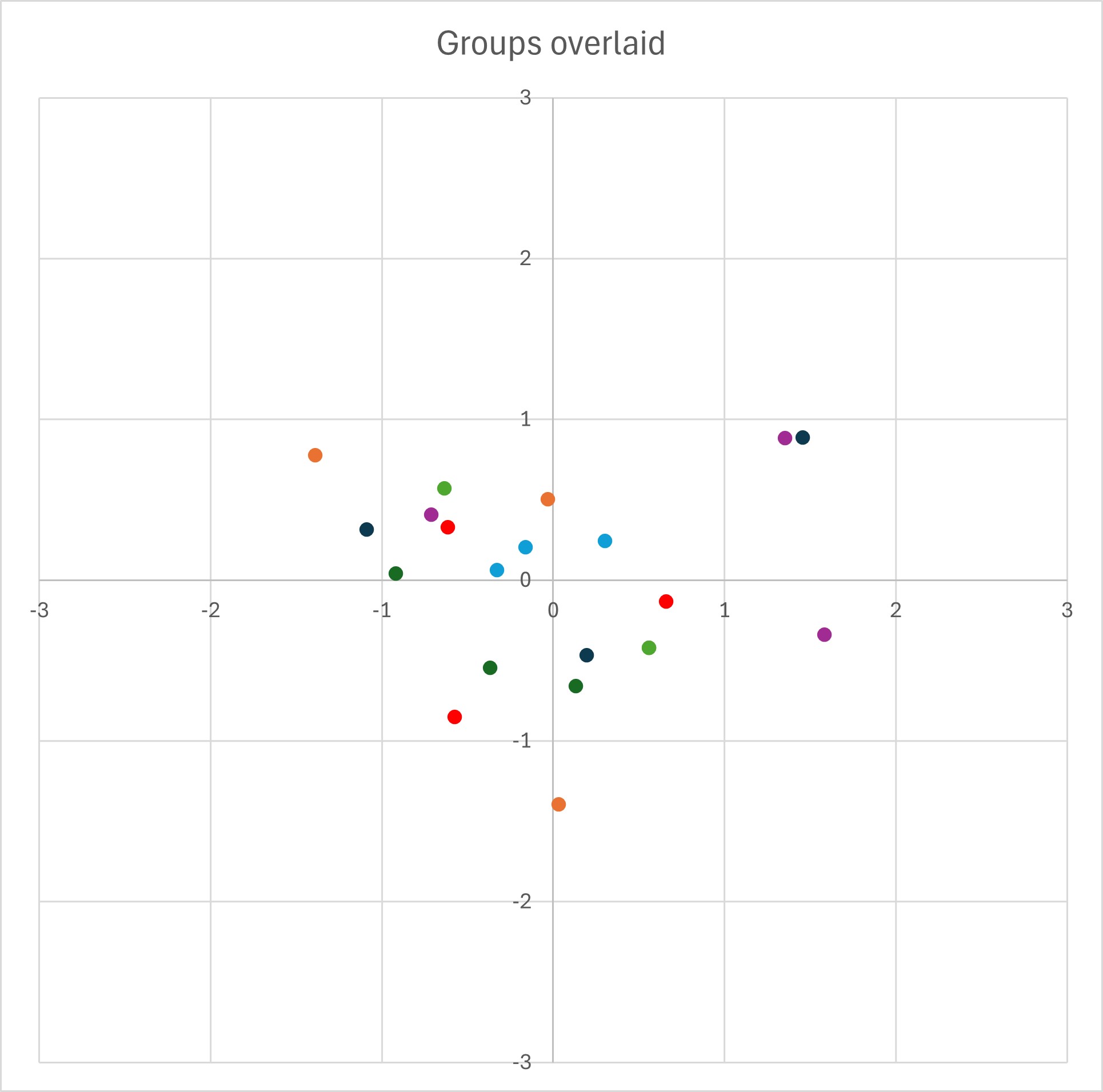
-
02-04-2025, 11:49 AM #171
This figure comes from hornady -
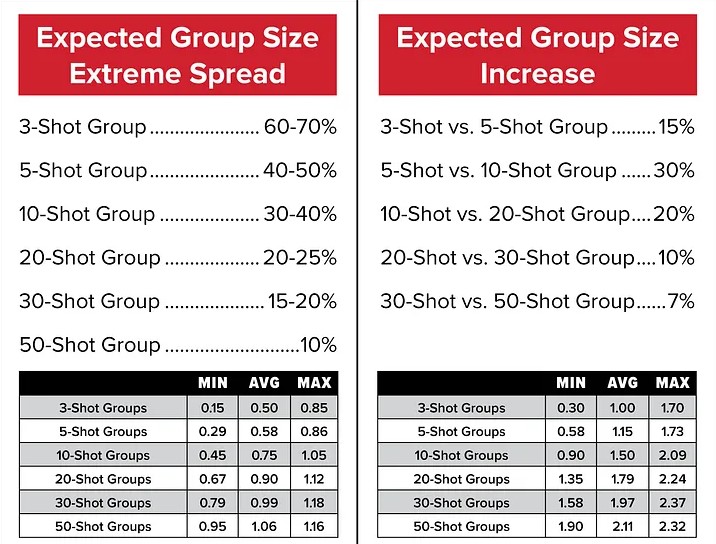
And it is consistent with my observed results - for example https://www.nzhuntingandshooting.co....3/#post1656779
With the factory ammo that shoots around 3.5MOA out of my rifle, 10x 3-shot group sizes showed a variation of + or - 60-70% from the average group size.
-
03-04-2025, 10:25 AM #172Member

- Join Date
- Dec 2024
- Location
- Manawatu
- Posts
- 88
Speaking from experience, I would have thought the correct answer to be - use up the remaining components, while making minor yet arbitrary changes to different variables.
Then take a photo of the best three shot group, and post with a title to the effect of "load development nailed, off hunting!".
-
03-04-2025, 06:32 PM #173Member

- Join Date
- Aug 2017
- Location
- Tauranga
- Posts
- 351
Cool to see some results, although I would have picked the charge with the lower es and ok on both sides, 25.1g�� As for the seating depth nice to see the changes in such small variations��
-
03-04-2025, 06:47 PM #174
To be clear the "changes" visible in 3 shot groups are within the variation that happens within 3 shot groups of a single load. At present there is no evidence at all of any difference between the seating depths. SD is meaningless for a sample of less than 10 at minimum, more like 20-30. I've loaded 20 of each and I'll shoot tomorrow or Saturday and post results.
-
05-04-2025, 12:17 PM #175
Okay so I went and shot these this morning. Conditions were good - essentially nil wind, my usual setup shooting at 100m with Atlas bipod & rear bag prone.
First, I did the process @McNotty suggested - 2x 3rd groups, and a 4rd group. Here are the results -
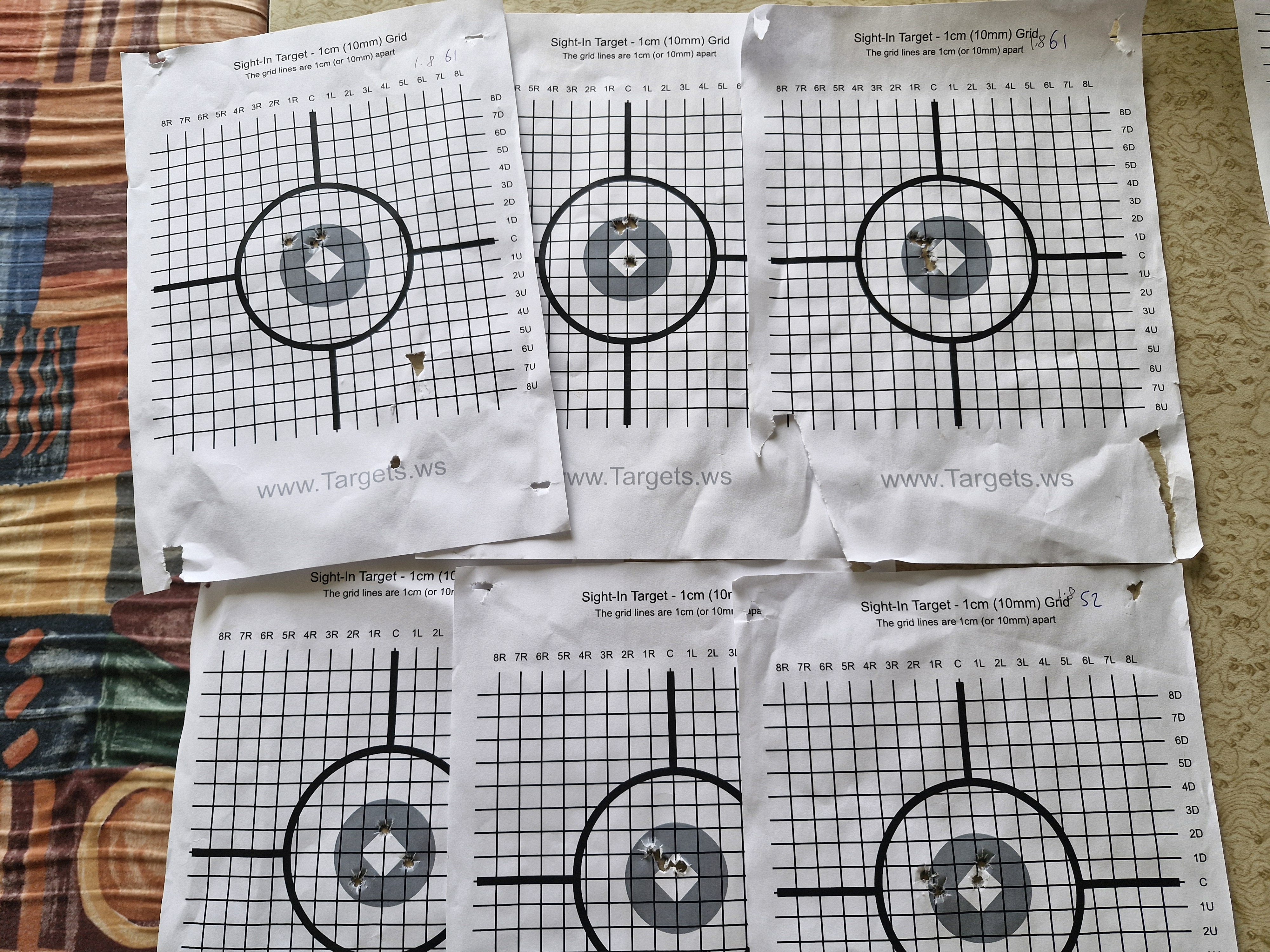
1.861 ("best" load identified) - produced groups of
3rd 1: 0.57 MOA
3rd 2: 0.79 MOA
4rd: 0.55 MOA
Mean radius from these 10 shots overlaid was 0.101MRAD and a 10rd aggregate group size of 0.79MOA. Looked pretty good.
1.852 ("worst" load identified - produced groups of
3rd 1: 0.85 MOA
3rd 2: 0.54 MOA
4rd: 0.89MOA
Mean radius from these 10 shots overlaid was 0.099MRAD and a 10rd aggregate group size of 1.21MOA. Looked ... actually basically identical to the 1.861 load if you look at MR rather than group size. The individual groups weren't obviously different either.
So then a 10rd group of each. Looked like this. This looks like a really bad group with the "better" load - the 1.861 CBTO. However bear with me through the results.
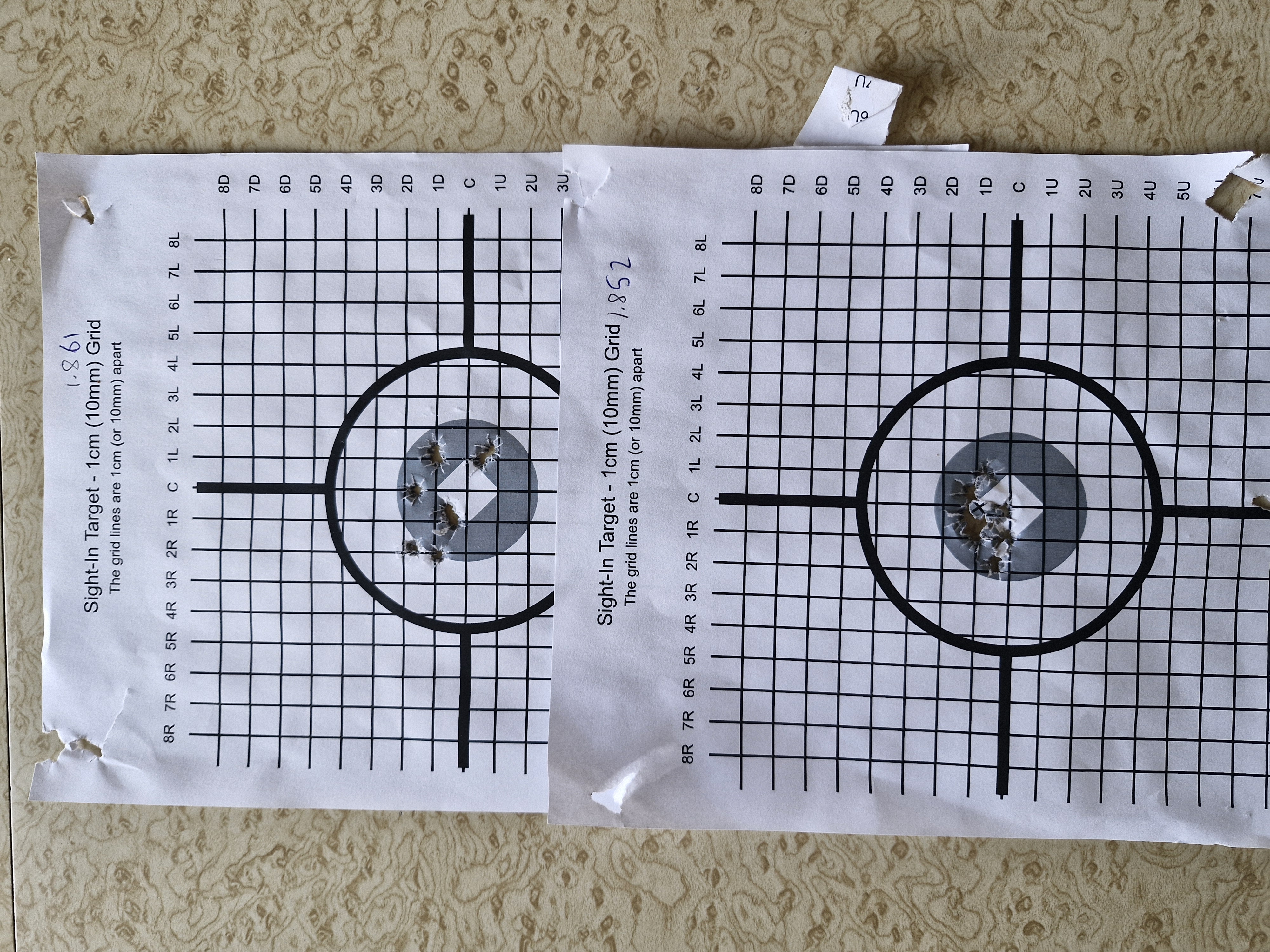
Best load 10rd group size - 1.37 MOA
worst load 10rd group size - 0.92 MOA
So what do the 20rd from each load look like when aggregated to one big 20rd group ?
1.861:

Mean radius: 0.116MRAD group size 1.37MOA (4cm). The predicted O95 from the 20rd mean radius is 4.8CM so the group size measured falls within expectations. This is a worse group than I "expected" but it is within the calculated expectations of all the data. Did I fuck it up and pull a couple of shots - change cheek pressure - did the wind gust a little bit L-R ? Who knows but it is what it is.
1.852:

Mean radius: 0.09MRAD, group size 1.21 MOA.
It does actually appear if you look at the MR, that either -
1. There is no functional difference between the loads and there is just a bit of natural variation due to measurement error etc showing up in the results
OR
2: I cannot shoot well enough to resolve any difference between these different loads, and the difference in the MR values is the "noise" from my shooter error
OR
3. The load identified as the "worst" through 3-shot group testing is actually slightly more consistent over large samples than the load identified as the "Best"
I do feel that I may have introduced a little error on the 10rd group of the 1.861 load and, had I not, it would have likely produced a more or less identical result to the 1.852. The variance in the mean radius is higher than you would expect from natural variation but there is likely a bit of measurement error here - the group analysis in the app isn't perfect. Regardless the results are functionally identical and fall within the cone of fire of the system even if a couple right at the edge were maybe contributed by a little extra shooter error.
Here's all 61 shots with this powder charge, and all seating depths - a 1.37MOA group with a mean radius of 0.096MRAD
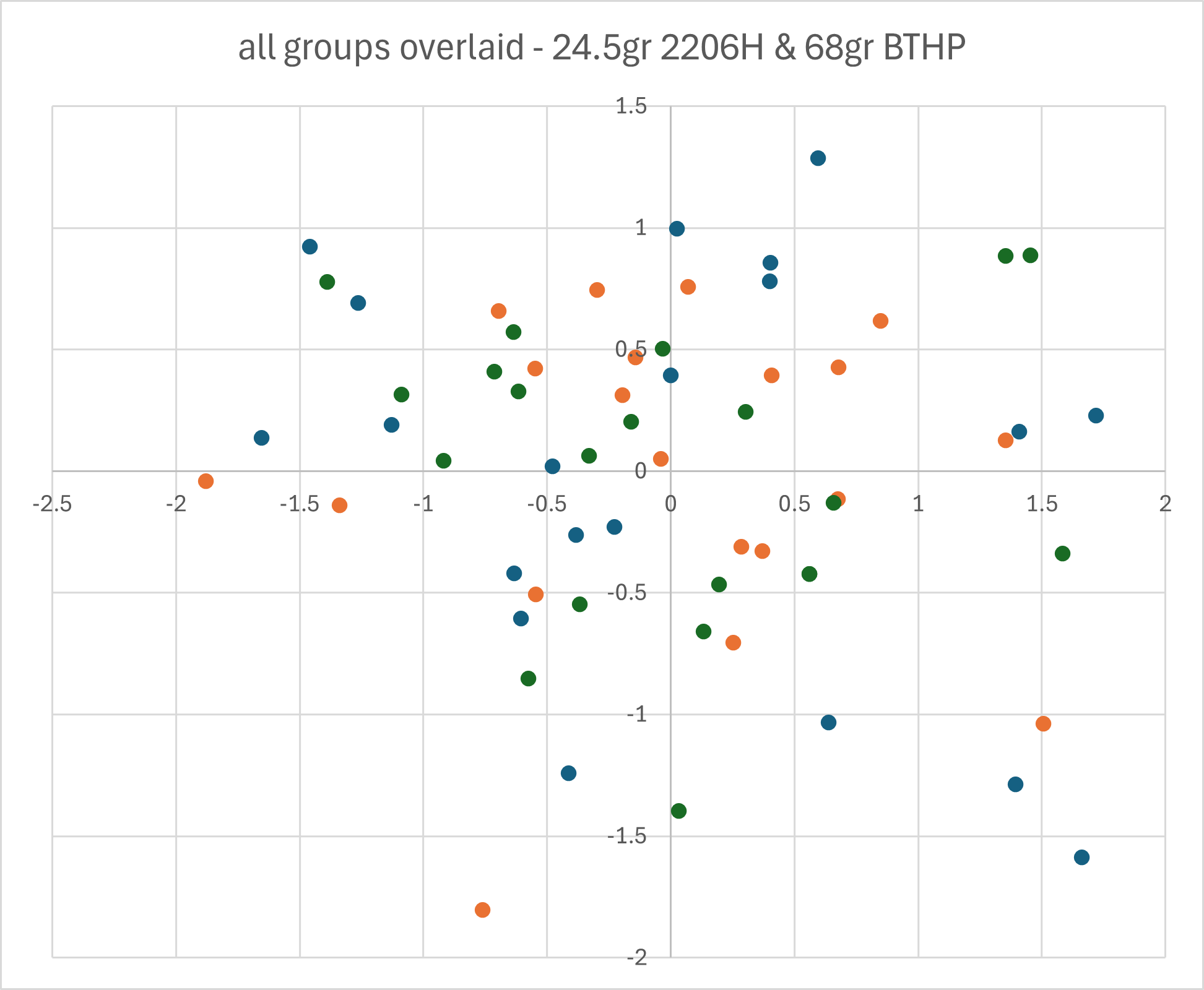
So conclusion - with this rifle, bullet, brass, powder and shooter combination it is not possible to identify any difference in precision between loads with different seating depths by testing with 3 shot groups, at .003 inch increments of seating depth (as recommended by Erik Cortina, if he isn't the person to listen to for this then who is ?). Or 20rd groups of same.
All results fall within the cone of fire predicted by the 10rd mean radius for any of the 10 rd groups for any load.
Writeup is a bit messy and rushed because I'm off hunting for a week
-
05-04-2025, 03:51 PM #176
Some further reflections -
1. I would not load this bullet in this rifle with this brass/powder. I now know this load does not meet my hit-probability requirements for precision (0.07MRAD mean radius or better, so that precision is not the limiting factor on 0.3MRAD targets).
2. I did not know that this load did not meet my requirements after 36 rounds of the conventional process. Often it is stated that "3 shot groups can't tell you how good something is, but they can tell you how bad it is and then you can rule it out". None of the 3-shot groups come close to representing the true size of the cone of fire and I could not rule the load out after 12x 3 shot groups. Clearly it was at least 0.895 MOA, as that was the largest 3-shot group - but that would meet requirements.
3. Nor did I know the true velocity consistency as measured by SD. 3-shot SDs/ES are useless to represent the true velocity consistency of a load.
I did not know enough to make a decision. A single 15-shot group of a single arbitrary load selected to be most likely to be functional would have given me much more useful information.
-
05-04-2025, 04:46 PM #177
I am so glad fishing isn't this mind boggling. My brain would melt if I had to collect and interpret this kind of data for my lure making. Not that I am making any at the moment. Which reminds me, @gimp your lure is about an hours worth of work from being finished, been like that for about 12 months

-
06-04-2025, 08:11 AM #178
Fortunely I've done it for you! No need. Life is simple, pick a good powder from ADI, a quality bullet, put it in good brass with a near max load seated to just short of mag length or something like 30 thou off the lands, whichever makes sense, shoot 10-15 of them, if it shoots good enough for you it's good, adjust speed and pressure as required, get a different bullet if it isn't good. Oh and start with a cut rifled match barrel bedded in a good stock if you want a good chance of actual sub-MOA precision
Keen as to get out on some kingis.... springtime is top water time...
-
17-04-2025, 10:15 PM #179Member

- Join Date
- Mar 2012
- Location
- Waikato
- Posts
- 2,186
Here's a 10 shot group from my 7mm08 at 100m off a bench rest.
1 cm grid.
Looks like the barrel's shot out ?
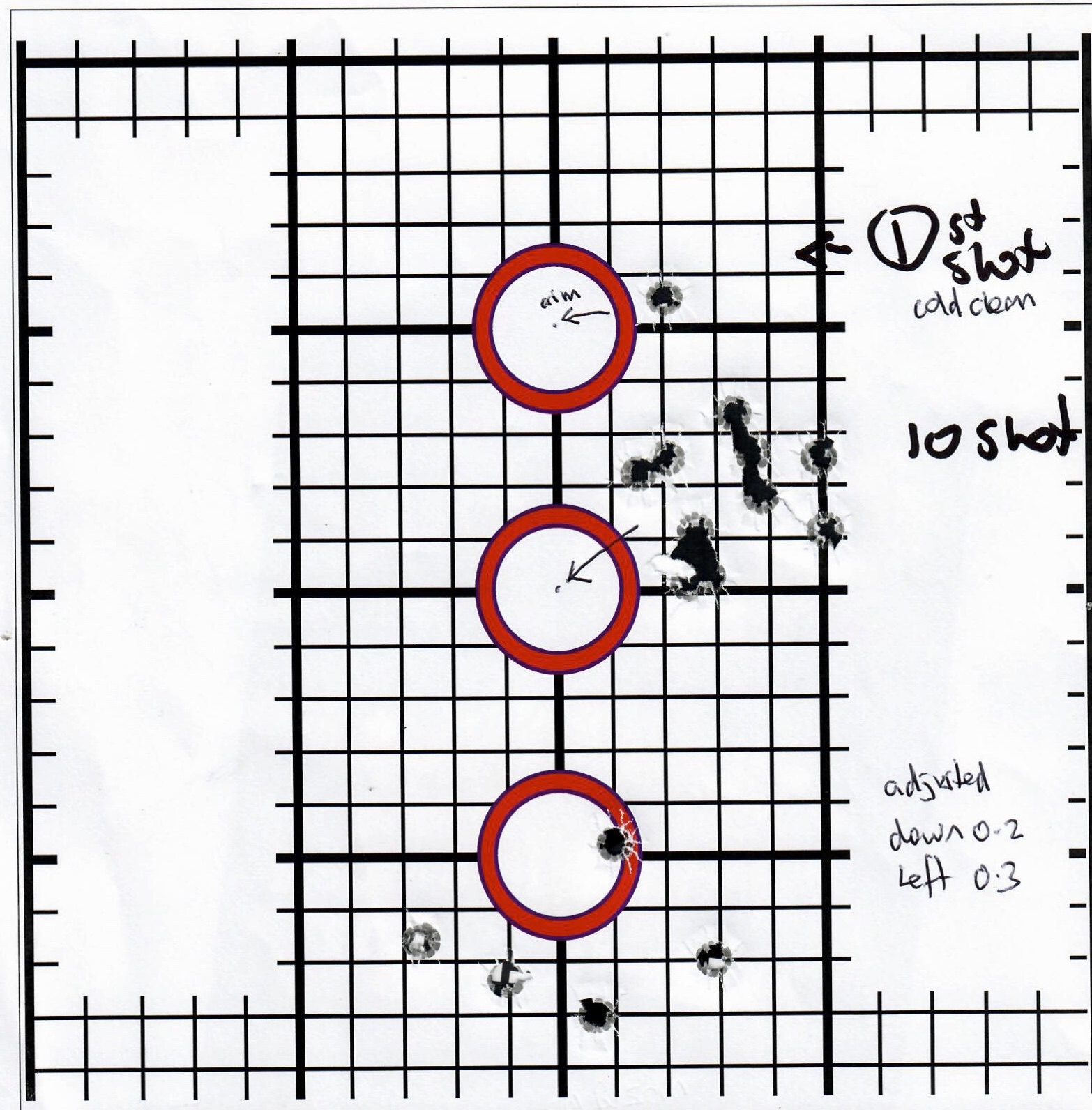
Returning to Gimp's first post in this thread:
I suggest a simpler and more efficient approach -
1. Define your requirements - what level of precision and velocity do you require? This requires sensible calibration of expectations - chasing smaller groups than most rifles can produce, and more speed than your chosen cartridge can generally produce, is perhaps not well-aligned to reality. Book max speed minus 15-50fps per inch for your actual barrel length is perhaps a good indicator of a realistic expectation for speed.
2. Select the most appopriate powder and bullet based on reasonably wide research, using good quality components
3. Load 10rd at a powder charge (within book data) that you predict will give the velocity target you'd like. It will be easier to be more precise in this estimate with more modern cartridges with lower variability in data. I suggest using more modern cartridges.
4. Load your COAL to be seated off the lands somewhere, and fit in your magazine. Forget about it.
4. Shoot to test
5. If velocity is in your target range, and precision meets your requirements, you are done.
So 35mm spread of centers (sorry, I haven't got the sd radius which would as @gimp says be a more reliable measure) predicts 70mm at 200m and 100mm at 300m which should leave enough margin for my own quite considerable aiming and wind estimating errors. I'd like a more flattering group but in fact it does meet my hunting requirements. I've previously debated whether the ft.lb number at 300m is good enough but suppose it is, then this load does actually meet velocity requirements too. Interestingly, 35mm for 10 shots was said to be equivalent to maybe 30% less (26mm) for 5 shots (post #171 on p 11 here) which is the manufacturer's accuracy guarantee when new. In practice, i haven't had a 5 shot moa group for a while.
I do a charge weight ladder mainly to demonstrate that 0.5 gr above my routine load is safe. I'm liking the idea of checking just a single load with 10 shots and I fully agree with Gimp that its very unlikely you can distinguish differences in precision with 5 shot groups. 10 shots loaded and fired on one day is way cheaper than returning two or three times to the range to refine my load.
I do use 5 shots is for defining group centre and adjusting zero, and don't go chasing the last 0.1 mRad. It's another story to prove it mathematically, but my rule of thumb is that if the point of aim is inside the circle of a 5 shot group, that's as good as you can get. The apparent centre wanders 0.1 or 0.2 mRad from one group to the next.
Similar Threads
-
Load development in the SI
By Strider B in forum Reloading and BallisticsReplies: 21Last Post: 02-09-2020, 09:31 AM -
A novel approach to Load Development
By Puffin in forum Reloading and BallisticsReplies: 2Last Post: 16-08-2018, 11:36 AM -
General approach to powder selection for a new load
By MGNZ in forum Reloading and BallisticsReplies: 9Last Post: 28-11-2017, 03:29 PM -
Load development
By Cartman in forum Reloading and BallisticsReplies: 8Last Post: 30-07-2015, 10:42 PM -
OCW Load Testing
By The Bloke in forum Reloading and BallisticsReplies: 44Last Post: 20-08-2014, 09:47 PM
Tags for this Thread
Welcome to NZ Hunting and Shooting Forums! We see you're new here, or arn't logged in. Create an account, and Login for full access including our FREE BUY and SELL section Register NOW!!





 259Likes
259Likes LinkBack URL
LinkBack URL About LinkBacks
About LinkBacks



 Reply With Quote
Reply With Quote



Bookmarks